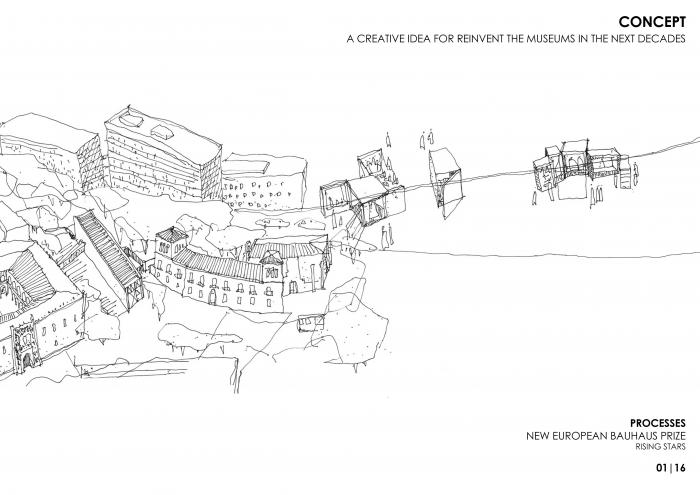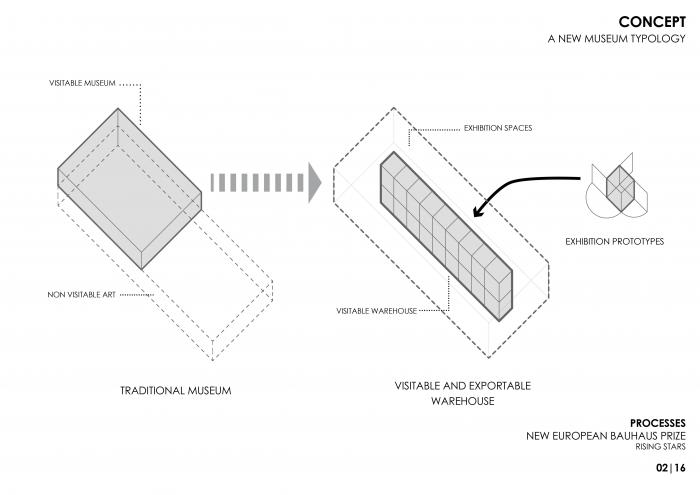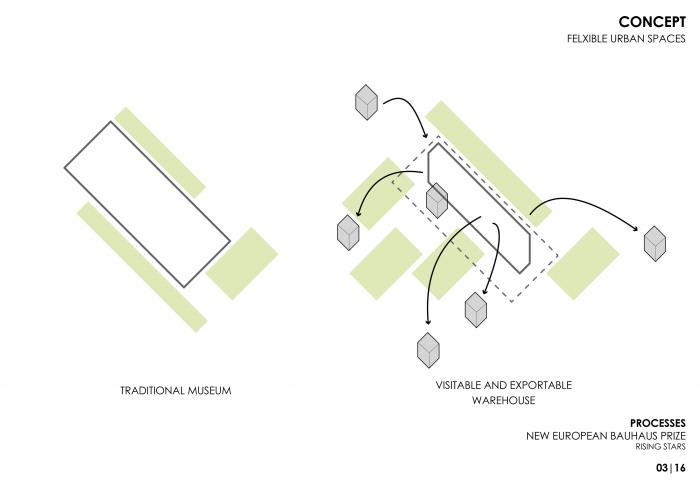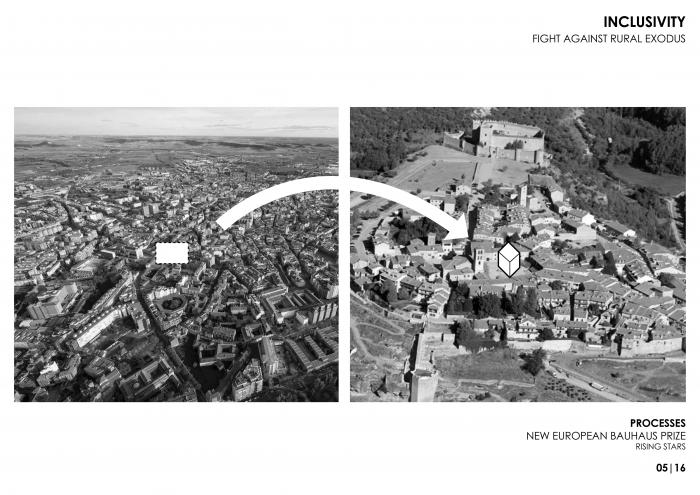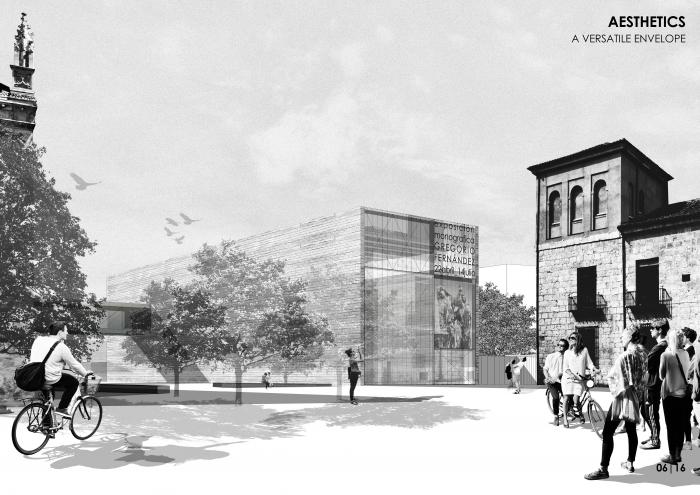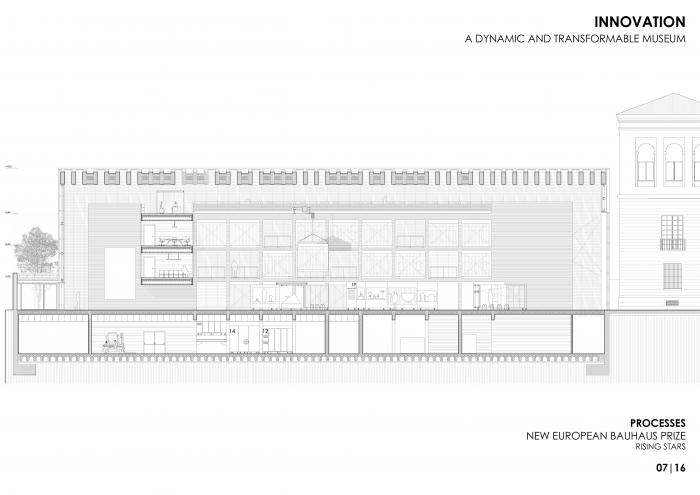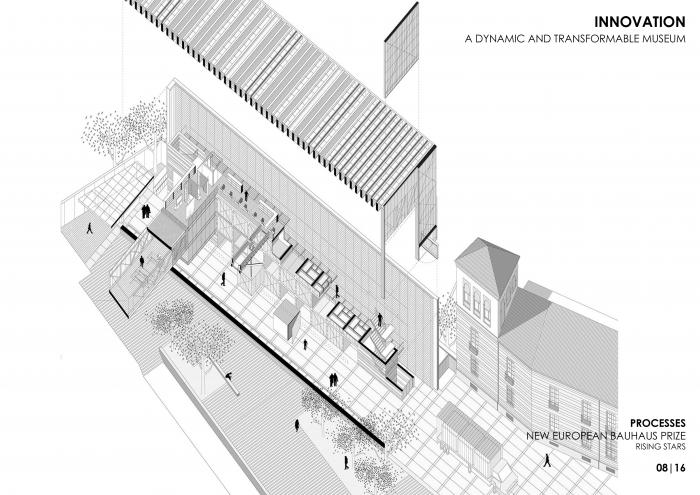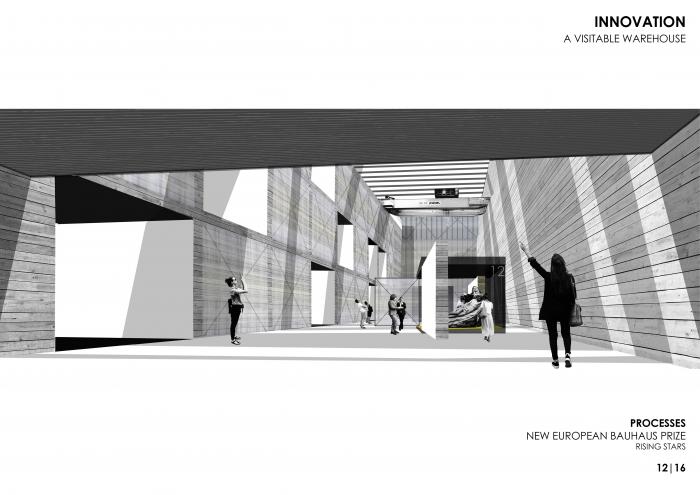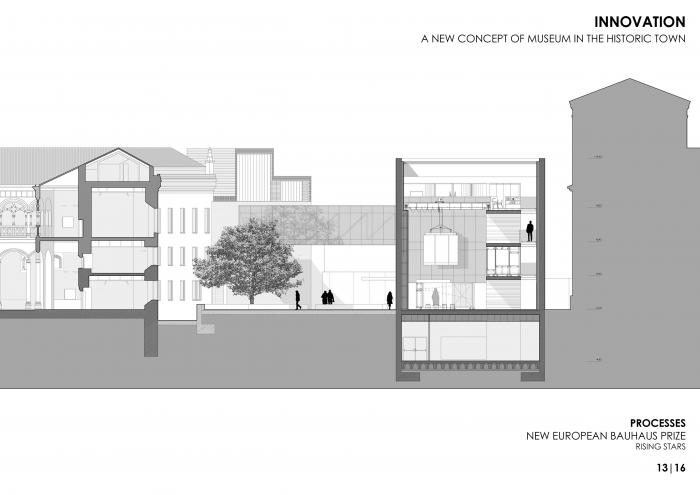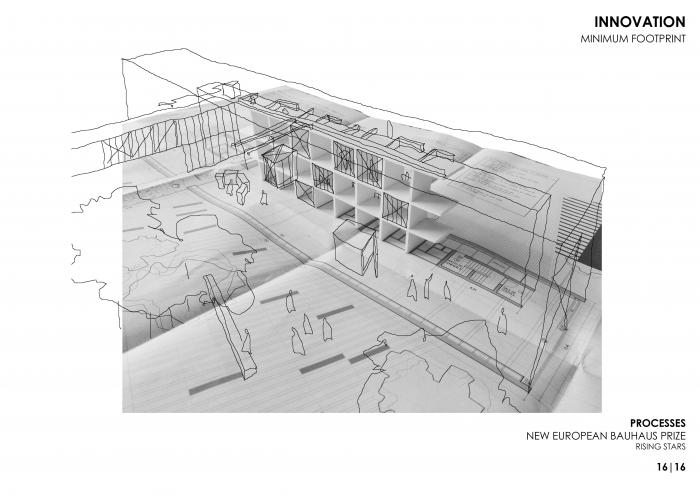I. SUMMARY INFORMATION
Project
268936
Status
Submitted
Award category
Preserved and transformed cultural heritage
You want to submit
NEW EUROPEAN BAUHAUS RISING STARS : concepts or ideas submitted by young talents (aged 30 or less)
Project title
PROCESSES
Full concept/idea title
PROCESSES - A creative idea to reinvent the conservation and exhibition of art in the next decades
Description
The history of Europe has always been linked to the avant-garde and artistic discoveries. Nowadays it is necessary to take on challenges such as the impact of tourism on our cities as well as facing the progressive aging of european population, the climatic emergency, the extreme urbanization and the rural exodus. PROCESSES is a creative idea and an alternative proposal for these issues. It is a typological reinvention of the museums as places in constant transformation connected to people.
Where is your concept/idea being developed or intended to be implemented in the EU?
Spain
Castille and Leon
Cadenas de San Gregorio Street
41.6574679
-4.7236221
Valladolid
47011
II. DESCRIPTION OF THE PROJECT
Please provide a summary of your concept/ idea
PROCESSES wants to imagine the museums of the coming decades. Its name is given to highlight the infinite solutions of exhibition and conservation which it offers, instead of proposing fixed result becoming the process (of creating, researching, exhibiting, visiting, discovering) a goal itself. PROCESSES wants to relate two realities occurring today in Europe:
Democratizing the access to art through a flexible, versatile and mobile exhibition and conservation system. Many of European art collections do not have as much impact or visibility as they should due to a lack of infrastructure. PROCESSES is a group of architectural prototypes ingeniously designed to create complete universes around a certain work of art or theme. It is a modular solution that adapts to all types of artistic formats: sculpture, small pieces, graphic documents and even intangible heritage.
Using the art to connect the urban areas of large European cities with rural regions that lose population every year. On the other hand, in countries marked by the rural exodus, PROCESSES is based on the ability of prototypes to house masterpieces of art which leave museums and temporarily benefit remote areas. PROCESSES firmly believes in the transformative capacity of art at all scales and in all settings. At the same time, it is an easy stackable system allowing museums to be turned into real warehouses that can be visited.
The project, which has a universal vocation, is originally conceived for one of the areas where these two situations converge. Valladolid, in Spain, is the capital of Castille and Leon, the most depopulated region in Europe. At the same time, the National Sculpture Museum located in this city, has been lacking of strategies to make itself known and to export and value its unique collection of pieces of art. PROCESSES is an idea that has been born to establish a creative response to these realities.
Please give information about the key objectives of your concept/idea in terms of sustainability and how these would be met
PROCESSES becomes aware of the issue of sustainability insofar as it is an architectural piece of the 21st century. The project achieves an improvement in sustainability from the conception through three main goals:
1. The minimum footprint. The European cities of tomorrow must be green parks in which the built mass is related with their natural spaces in a balanced way. The PROCESSES project aims to provide an alternative to the large built areas that we have inherited. The design of prototypes housing masterpieces of art will lead to create stackable museums and visitable warehouses where spaces are more efficient. This attitude will free up a large amount of surface which could be used for parks, gardens or public space.
2. Industrialized modular systems and low-carbon building materials. On the other hand, the idea of creating modular and standardized prototypes allows us to take up the reflections of industrialized architecture that generates economic solutions without forgetting handcrafts techniques. The structural system developed is designed for the predominant use of materials that have a low carbon impact such as recycled wood and steel. At this point there is a double aim in the constructive system; firstly, being sustainable itself and secondly, raising awareness of these solutions as the most consistent ones in the near future.
3. Urban regeneration: The PROCESSES project wants to be an adaptable solution to multiple urban situations. In this way, the project is interested in giving alternative ideas for urban regeneration. The prototypes that will house the masterpieces can be adapted to multiple architectural formats. The use of degraded industrialized spaces and the new possible life of a lot of city historical centres are especially interesting. In addition, the versatility and reversibility of the proposal allows the transformation of remaining places multiple times without fixing them to a specific use. The value lies in spatial recycling.
Please give information about the key objectives of your concept/idea in terms of aesthetics and quality of experience beyond functionality and how these would be met
The PROCESSES project also represents a reflection on aestheticism as an architectural piece. The image follows the function for which the prototypes are conceived: the creation of visitable warehouses and easy exportation of art. The aesthetic aspects are defined by three main ideas:
1. The exhibition prototype itself. The exhibition boxes are cubic pieces of 3x3x3 m that try to contain an infinite universe of possibilities in a very pure geometry. The storage of these pieces establishes the basis of a new type of museum in which everything is shown and accessible to the public. The materials of these boxes are mainly wood and recycled steel. This selection conditions an aesthetic and it is used as a propaganda of recycled materials as well. The specific features of the exhibition prototypes are defined according to the preservation conditions of the art pieces that they will house. However, the use of low impact materials such as polycarbonate or recycled natural elements is preferred.
2. A versatile envelope. The idea of the PROCESSES project can be applied in a multitude of urban situations. It is a tool for creative uses in degraded urban spaces, colonizing them with art. These versatile warehouses create facade envelopes capable of adapting to different environments, blending in with the immediate context, using it for vegetation, energy creation or standing out as an icon when necessary. In the specific case study in Valladolid (Spain), the envelope is silent and is camouflaged with the textures of the historic city centre.
3. Creation of specific universes in relation with a piece or a theme. The great opportunity of the exhibition prototypes is the organization of related selections of works through the same theme or reflection. This will create surprising or predictable realizations. The prototypes try to define an aesthetic and intellectual approach to the pieces and works of art to be preserved.
Please give information about the key objectives of your concept/idea in terms of inclusion and how these would be been met
The PROCESSES project was born with the intention of giving to society a democratized, creative and avant-garde access to the large number of art collections that exist today in the continent. It is an idea that tries to update many of the museums that exist to the needs of the 21st century through architecture. It is an idea conceived by and for people.
1. Visibility for small art collections. Despite the abundant number of art collections and museums in Europe, many small organizations do not have enough resources to achieve the visibility they deserve to preserve our heritage. The PROCESSES project can be a real opportunity for these small collections, allowing their art pieces to travel without altering their conservation conditions and increasing their impact on other areas.
2. Fight against depopulation and heritage conservation. Many of the European regions pale in comparison to a few urban areas that are increasingly dense. The idea of using art and bringing it closer to these regions at risk of depopulation transmits the message of art as a common good. This will help, feeding back this process in which the main objective is artistic preservation and its appropriation by society. Art itself is capable of transforming our lives and our reality and of preparing us for a new era in the decades to come.
3. Democratize museums as open warehouses. Museums and art collections usually allow a very limited access to their works. The PROCESSES project tries to democratize access to museums by creating authentic open warehouses where exhibited pieces are selected and set up. Specialized researchers and visitors will be able to naturally access a large part of these collections. This would create a new unprecedented architectural typology as visitors and the conservation of the pieces are the main actors.
Please explain the innovative character of your concept/ idea
The PROCESSES project and the designed exhibition prototypes are innovative in the way of exhibiting, preserving and exporting art. It is a new way of thinking about how to make art more accessible and democratized, reaching a wider and more remote public in regions with a need of cultural stimulation to survive.
1. A new type of museum for the incoming decades. The main innovative aspect of the project is to conceive the museum in a completely new perspective. The museum is thought as a dynamic and changing place always in transformation. To get this idea, a storage system for art pieces is proposed shaped in exhibition prototypes that can be visited in their stocked position. At the same time, these pieces open up and display an infinity of exhibition possibilities. In this way they can be moved to larger exhibition areas within the museum for their contemplation, playing with different displays depending on the purpose of the museum.
2. Conservation of heritage. This idea of a museum composed by individual exhibition prototypes almost tailored to the pieces of art, allows different conservation requirements within each one of them. In art collections, temperature, humidity and other factors vary from one piece to another. This system will help to fragment the exhibitions and adapt the conservation methods according to the specific needs of each piece or group of them.
3. Territorial impact. Exportable museums from their conception. Some of these prototypes will always be ready to travel, move and be exhibited in other environments. At the origin of the project, this idea was conceived to generate a positive impact in areas with high rates of aging and depopulation. Art becomes more accessible through its configuration, but also through its ability to travel and be more exportable.
Please detail the plans you have for the further development, promotion and/or implementation of your concept/idea, with a particular attention to the initiatives to be taken before May 2022
On the one hand, the PROCESSES project has the desire to be applied in Castille and Leon (Spain) the region for which it was developed, but by its own condition it aspires to be an exportable solution to be applied in different parts of Europe. Thinking globally and acting locally.
The project already has the interest and support of public institutions which know it and have seen it born, such as the University of Valladolid, the Association of Architects of Castille and Leon or the National Sculpture Museum. The next steps are :
Phase 1. In the first place, the construction of an exhibition prototype with the support of museum experts and reaching the main requirements for heritage conservation. This prototype will have two main functions: firstly, to be a test for the museum, or museums interested in its use; secondly, using it as a claim, generating a first impact on the cities and regions it travels to and visits. This phase could be developed before the end of 2021.
Phase 2. Once this first prototype has started its journey, it will be time to build two other typologies already designed as variants of the first: one for the conservation and exhibition of small-format masterpieces (posters, goldsmith objects, fabrics ...) and another for intangible heritage (music, smells, sensations ...). These two new prototypes could be assigned to the same museums that participated in the first phase or to others interested as a result of the trips of the first one. This phase could be developed before May 2022
Phase 3. From this moment on, the culmination of the process involves the construction of a small visitable warehouse housing these pieces while allowing their use and movement. This phase could be developed by the end of 2022.
The New European Bauhaus 2021 award for the PROCESSES project would be the real opportunity to build the first prototype of what will undoubtedly be a revolution in the way of understanding, conserving and relating to our heritage.
III. UPLOAD PICTURES
IV. VALIDATION
By ticking this box, you declare that all the information provided in this form is factually correct, that the proposed concept/idea has not been proposed for the New European Bauhaus Rising Stars Awards more than once in the same category.
Yes
